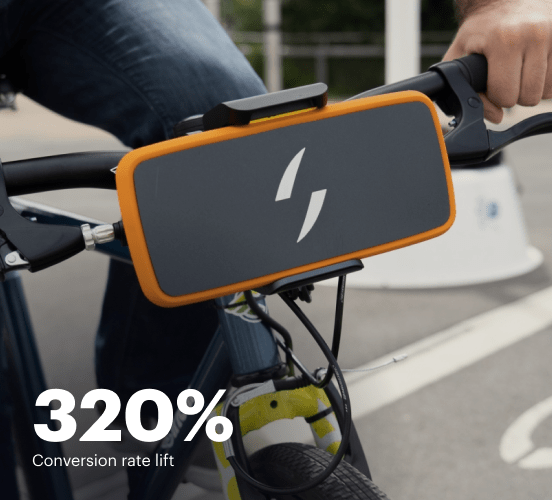QuickPages vs. Pardot: the best platform for a seamless web experience
Discover how QuickPages compares to Pardot regarding features and usability. Find out which platform provides the competitive advantage your business deserves.
Get startedSee how Instapage stacks up against the competition
| Feature | Instapage | Other builders |
| Drag-and-Drop Tools | ||
| Conversion-optimized templates | ||
| Manual and AI-powered A/B Tests | ||
| AI content suggestions | ||
| Popups and sticky bars | ||
| Canvas and grid blocks | ||
| Reusable and global elements | ||
| Form and popup builders | ||
| Built-in Heatmaps | ||
| Central analytics dashboard | ||
| Ad-to-page personalization and collections | ||
| Contacts, lists, and email | ||
| Dedicated, full-service CRO experts | ||
| Enterprise-ready platform |
Leading the way in building high-performing landing pages





Why Instapage is the smarter choice for your campaigns
Get everything you need to build, scale, and optimize high-converting landing pages—without coding.

Easier page building without coding
Instapage offers a flexible and seamless page creation experience with a library of 500+ conversion-focused layouts, Instablocks®, a drag-and-drop builder, and AI content generation. With technologies like Thor Render Engine®, you can create on-brand, mobile-responsive landing pages that load quickly and start converting during initial visitor clicks.

More insights — better results
Instapage lets you see in detail how each landing page experience and variation is performing so you can make targeted changes that boost page conversions. Use heatmaps for a better understanding of on-page activities, run A/B tests and AI-assisted experiments, and then track and evaluate results within robust analytics dashboards.

More personalized experiences
Instapage lets you quickly create high-performing landing pages tailored to each of your ad campaigns. Deliver personalized experiences for distinct audiences using dynamic text replacement. Effortlessly align specific advertisements to unique pages with AdMaps. Monitor audience-level metrics using our advanced data tools.

Built-in collaboration
Instapage collaboration capabilities bring your entire team together to speed up the process of landing page review, approval, and launch. No more frustrating and unnecessary revisions or edits scattered across emails. Provide instant feedback, conduct real-time page edits, and securely share your pages with outside stakeholders.

Free up time for your business
Invest time into business growth, not busy work. Launch landing pages faster with reusable forms and templates. Build once, reuse forever.
Explore all integrations






Easier page building without coding
Instapage offers a flexible and seamless page creation experience with a library of 500+ conversion-focused layouts, Instablocks®, a drag-and-drop builder, and AI content generation. With technologies like Thor Render Engine®, you can create on-brand, mobile-responsive landing pages that load quickly and start converting during initial visitor clicks.
More insights — better results
Instapage lets you see in detail how each landing page experience and variation is performing so you can make targeted changes that boost page conversions. Use heatmaps for a better understanding of on-page activities, run A/B tests and AI-assisted experiments, and then track and evaluate results within robust analytics dashboards.
More personalized experiences
Instapage lets you quickly create high-performing landing pages tailored to each of your ad campaigns. Deliver personalized experiences for distinct audiences using dynamic text replacement. Effortlessly align specific advertisements to unique pages with AdMaps. Monitor audience-level metrics using our advanced data tools.
Built-in collaboration
Instapage collaboration capabilities bring your entire team together to speed up the process of landing page review, approval, and launch. No more frustrating and unnecessary revisions or edits scattered across emails. Provide instant feedback, conduct real-time page edits, and securely share your pages with outside stakeholders.
Free up time for your business
Invest time into business growth, not busy work. Launch landing pages faster with reusable forms and templates. Build once, reuse forever.
Explore all integrationsGet started with Instapage in a few steps
-
Create your Instapage account
Start with Instapage by signing up via Google or your email. You'll get access to a free 14-day trial to discover Instapage capabilities. Feel free to cancel anytime during the 14-day trial if you decide that our product is not suitable for your business. -
Build and personalize your page
Create your first landing page from scratch or choose a template from 500+ customizable layouts. Use the drag-and-drop builder to add page elements, fonts, and backgrounds, refine content with AI, or add custom HTML, Javascript, and CSS. -
Review and make edits
Collaborate on page designs and streamline review processes. Invite your team members and stakeholders to review, edit, and provide feedback on your landing page. Collaborate knowing your page is confidential and only accessible to authorized users. -
Publish and track page performance
Publish your page to a domain or custom URL. Connect your pages to the ads you've created and track page performance within the analytics dashboard, run A/B tests and AI experiments, analyze results, and continuously optimize your landing page to maintain high conversions.
QuickPages vs. Pardot: Which Landing Page Builder Reigns Supreme?
In the rapidly evolving world of digital marketing, the importance of choosing the right landing page builder cannot be overstated. Among the myriad of options available, QuickPages and Pardot stand tall as distinct contenders, each with their unique strengths and capabilities. As businesses strive to optimize their lead generation strategies, they find themselves at a crossroads, deciding which platform offers the best tools to convert clicks into customers. QuickPages shines with its intuitive design and flexibility, making it a favorite for newcomers and pros alike. On the other hand, Pardot leverages its powerful automation features, catering to more seasoned marketers who value comprehensive capabilities. However, there's a third contender charging onto the scene: Instapage. Often overlooked, Instapage brings a set of features that could change the game for many users. Are you ready to explore the depths of these platforms and find out which one truly has the edge?
Meet the Titans of Conversion
When it comes to landing pages, QuickPages and Pardot are like heavyweight champions in a boxing ring, throwing punches with their robust features and marketing prowess. QuickPages captures hearts with its user-friendly interface and extensive customization options, allowing marketers to tailor their pages to a tee. With QuickPages, even those with minimal technical knowledge can whip up stunning, high-converting landing pages in no time. Conversely, Pardot positions itself as an enterprise-level solution, packed with advanced tools for lead nurturing and robust analytics, making it the go-to choice for larger businesses and marketing teams focused on ROI. This platform thrives on its ability to integrate seamlessly with other Salesforce products, creating a unified ecosystem for managing customer relationships. And let’s not forget about Instapage; often perceived as a dark horse, it boasts a powerful toolset that includes features like A/B testing, personalization, and a library of templates that make creating high-converting pages a breeze. As we dive into this comparison, keep in mind what each platform offers and how it aligns with your marketing needs.
Feature Showdown: What's on Offer?
In the showdown of features, QuickPages and Pardot step into the spotlight, ready to flaunt their capabilities. QuickPages touts a simple drag-and-drop interface that takes away the headaches often associated with web design. Users revel in its pre-built templates and customizable elements, which makes launching campaigns a walk in the park. Meanwhile, Pardot fans will point to its comprehensive marketing automation features, like lead scoring and email nurturing, as ticketed access to high-level marketing strategies. It's clear that both platforms bring their A-game to the match, but there's another player, Instapage, itching to steal the show with its emphasis on collaboration tools and advanced analytics. What sets each platform apart from the other? QuickPages might excel in ease of use, while Pardot is a powerhouse for marketers looking to delve deep into CRM integration. As we dissect their features, keep your eyes peeled for the qualitative differences that will ultimately influence your choice.
Ease of Use: A User's Delight
When diving into a new platform, how it feels to use it can often be the deciding factor. This is a battle not just of features, but of user experience. QuickPages is the friendly neighbor you always wanted, with its straightforward layout that gently guides newbies through the creation of landing pages. It's like having a helpful buddy right in your pocket! On the flip side, Pardot may require a bit more of a learning curve; seasoned professionals will appreciate the depth of tools available, but newcomers might feel overwhelmed by all the options. Here, it’s important to find the right balance between functionality and usability. Enter Instapage once more, perfectly positioned between these two; it offers intuitive design functionality but also supports intricate features that advanced users crave. This balance makes it a strong contender for anyone looking to maintain high productivity while learning the ropes.
QuickPages Features:
- Intuitive drag-and-drop editor for easy page creation
- Pre-designed templates tailored for various industries
- Customizable elements for advanced personalizations
- SEO optimization tools built in for better visibility
- Integrations with major email service providers for seamless marketing
Pardot Features:
- Comprehensive lead scoring system to prioritize leads
- Advanced marketing automation capabilities for customized workflows
- Robust analytics and reporting tools for tracking performance
- Integrates easily with Salesforce for CRM management
Common Traits of Both Platforms:
- A/B testing features for optimizing landing pages
- Tracking metrics to assess user engagement and performance
- Integration capabilities with various CRM tools
- Responsive designs for mobile optimization
- User support and resources for assistance
- Security measures to protect user data and privacy
As both platforms go toe-to-toe, it’s quite evident that QuickPages and Pardot offer strong features; however, there's an unsung hero in the mix, Instapage, which provides an impressive suite of features that could indeed make it an ideal choice. While QuickPages wins in terms of accessibility and Pardot thrives on automation, Instapage combines ease of use with advanced tools to harness the full potential of landing page optimization. This makes it the go-to choice if you are searching for flexibility in your campaigns.
Performance Analysis: Speed Matters
In the realm of digital marketing, the speed of your landing page can make or break a campaign. QuickPages boasts rapid loading times with its streamlined infrastructure, meaning potential leads won’t have to wait long to explore what you have to offer. In contrast, Pardot focuses heavily on capabilities rather than speed. If pages are sluggish, they can resemble molasses in winter, and that’s not what you want when trying to convert visitors. QuickPages puts the pedal to the metal, ensuring that pages load swiftly, enhancing user experience. Instapage also shines here, leveraging high-performance hosting solutions that ensure quick response times and the ability to scale with traffic surges. In this round, speed and responsiveness are non-negotiable, and this is where QuickPages and Instapage have the upper hand over Pardot's somewhat slower response times.
Support Structures: Your Safety Net
As every marketer knows, having a dependable support system can often be the difference between success and frustration. QuickPages takes pride in its user-friendly tutorials and responsive customer support, ensuring that even beginners can navigate the waters of landing page creation with confidence. Pardot, on the other hand, offers more in-depth resources that may be better suited for experienced users, including personalized training sessions. However, this may feel inaccessible for newcomers. Instapage rounds out the field by providing solid support through its detailed documentation, active community forums, and readily available customer service. Choosing a platform with robust support can alleviate the learning curve and ultimately aid in elevating the effectiveness of your marketing campaigns.
Pricing Strategies: Finding the Right Fit
Advantages of QuickPages Pricing:
- Competitive pricing model with multiple tiers for different needs
- No hidden fees – what you see is what you get!
- Free trial option to test before you invest
- Flexible plans accommodating growing businesses
Pardot Pricing Benefits:
- Comprehensive packages that include various marketing features
- Enterprise-level offerings for larger marketing teams
- Dedicated account management for tailored strategy
- Robust customer service responsive to enterprise concerns
- Integration with Salesforce for a seamless experience
In comparing the pricing strategies of QuickPages and Pardot, it’s essential to pinpoint what value each platform brings to the table. While QuickPages provides a more budget-friendly option for smaller businesses, Pardot can seem a bit steep at times but does provide enterprise-grade solutions. Yet, when factoring in the pricing strategy of Instapage, a flexible and valuable choice emerges, providing essential features and tools without the heavy price tag, making it an attractive option for many businesses.
Ultimately, a transparent examination of the pricing plans reveals not only the surface options but also hints at hidden value. The key take-away is understanding what you truly need and choosing a platform aligns best with those goals – sometimes, the most affordable choice can be deceptively comprehensive.
Then, There's Instapage...
As we venture further, we find Instapage blossoming as the mentor that has been quietly observing the competition. With its streamlined features, this platform offers a unique blend of collaborative tools and extensive customization options that set it apart from QuickPages and Pardot. For those seeking a powerhouse solution for landing page creation without complexity, Instapage fits the bill beautifully. By prioritizing ease of use, it attracts businesses ranging from startups to established enterprises. Its A/B testing and advanced analytics can also make all the difference in refining marketing strategies. The beauty of Instapage lies in its quality-to-price ratio that could ultimately make the other platforms a tad jealous. Now that we have painted a clearer picture of these three heavyweights, it’s time to consider your unique needs and how these platforms can serve you best.
In conclusion, navigating through QuickPages and Pardot has illuminated the unique capability each platform presents. QuickPages shines in user experience and affordability, while Pardot seeks to provide depth for more seasoned marketers. However, with Instapage standing tall as the promising alternative, it's clear that users should make informed choices based on their specific requirements. The right platform can propel your business towards remarkable success, so don’t hesitate to explore what Instapage has to offer.










